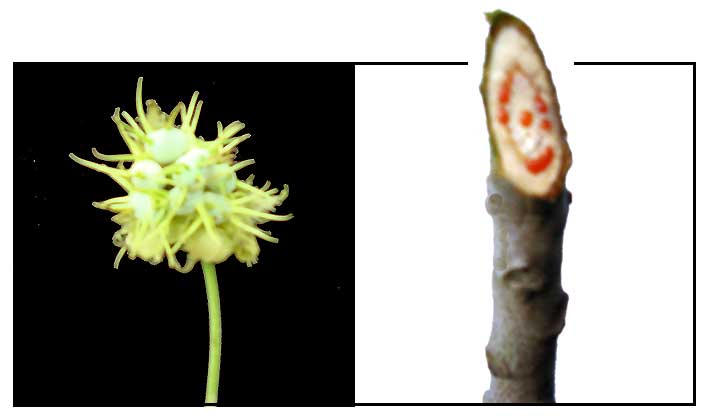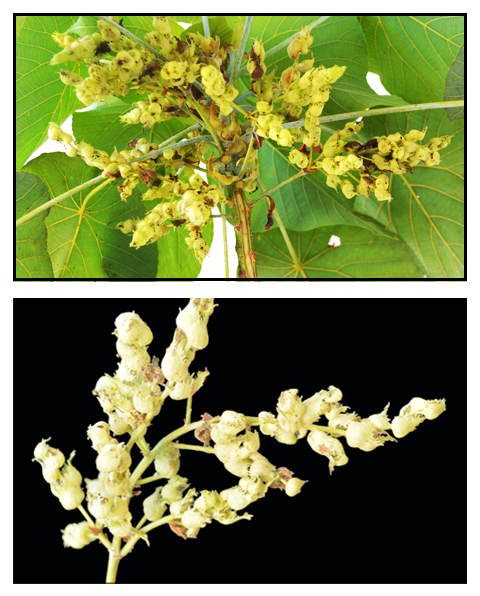|

Botany
Binuñga is a small, dioecious tree,
growing to a height of 4 to 8 meters. Leaves are peltate, ovate to oblong-ovate, 10 to 25 centimeters
long, with entire or toothed margins, with a rounded base and pointed apex. Male flowers are small and born on slender, branched
peduncles which are shorter than the leaves. Female flowers are usually found in simple panicled spikes or
racemes. Capsules are 10 to 12 millimeters in diameter, of 2 or 3 cocci, covered with pale,
waxy glands and with soft, scattered, elongated spinelike processes.
 Distribution Distribution
- In thickets and secondary forests,
at low and medium altitudes throughout the Philippines.
- Also found in the Andaman Islands and Malay Peninsula to southern China and Taiwan southward to northeastern Australia.
Photo insert
Flower (L), and cut branch
exuding reddish sticky resin used as glue (R).
C onstituents onstituents
• Phytochemical studies of leaves
yielded three new constituents: tanarifuranonol, tanariflavanone, and tanariflavanone D with seven known compounds. (see study below) (4)
• Chemical study on the bark isolated 10 known tannins:
corilagin, mallotinic acid, geranilin, macarinin A, putranjivain B,
putranjivain A, mallotunin, mallophilnin, repandusicnic acid A and phyllanthusiin
C.
(5)
• Bark yields a resin-glue.
• Two new prenylflavanones, tanariflavanones A and B, and one known compound, (–)-nymphaeol-C were isolated from the fallen leaves. The flavonoids exhibited phytotoxic activity.
• Stems yielded diterpene ketol, macarangonol, terpenoids and steroids.
• Study of ethyl acetate fraction of leaves yielded four flavonoids: nymphaeol C (1), solophenol D (2), nymphaeol A (3), and nymphaeol B (4). (see study below) (19)
• An ethanol extract of fruits yielded seven new prenylated stilbenes, schweinfurthins K-Q (7-13), along with vedelianin (1), schwenfurthins E-G (2-4), mappain (5), and methyl-mappain (6). (see study below) (20)
Properties
• Considered emetic, antidysenteric, antioxidant, antibacterial.
• Studies have suggested anti-inflammatory, antioxidant, cytotoxic, antidiabetic, alpha-glucosidase inhibiting, ferrous-ion chelating, analgesic, antimicrobial, antiplasmodial properties.
Parts utilized
Bark, leaves, stems, roots.
Uses
Edibility
· Fruits are added to palm juice, then boiled to crystallize, and used to improve the quality of sugar. (16)
- Bark and leaves use in making a fermented drink, basi, (16)
Folkloric
· Powdered roots used as emetic;
decoction for hemoptysis.
· Decoction of bark and roots used for dysentery and hemoptysis.
· Decoction of roots used for fever and to suppress coughing.
· Decoction of sliced young leaves used for diarrhea.
· Glue from stems applied to toothaches.
· Glue from stems applied to aphthous stomatitis.
· Leaves used for wound healing and inflammation.
· Bush medicine in Australia
records the use of the sticky and waterproof latex as sutureless stitching
for deep cuts.
· In Thailand decoction of root is drunk as antipyretic and antitussive. Dried root used as emetic. Fresh leaves used to cover wounds as anti-inflammatory.
· In Malaysia, used to treat diarrhea and dysentery.
· In Indonesia, plant used to treat diarrhea, injuries, and inflammation.
Others
· Glue: Glue from the tree bark used
for fastening parts of musical instruments.
· Wood: Wood used as structural timber.
· Basi: Bark and leaves used in making "basi," a fermented
drink.
· Crafts: In Sumatra, bark material used to make containers.
· Pulp: Yields a high quality pulp and produces a high quality particle board.
· Tannin: Bark contains tannin used for toughening fishing nets.
 Studies Studies
• Prenylflavanones / Cytotoxicity: Macaflavanones A-G, Prenylated
Flavanones from the Leaves of Macaranga tanarius: The
study isolated seven new prenylated flavanones, macaflavanones A-G,
along with two known compounds. The cytotoxic activities of the isolated
flavanones were assayed, with macaflavanone being the most active. (1)
• Radical-Scavenging Activities:
Four new megastigmane glucosides were isolated. Manganoside A-C and
mallophenol B possessed a radical-scavenging activity. (2)
• Leaf Constituents / Anti-Inflammatory / Antioxidant / Cytotoxic: Study yielded three new constituents from the leaves of M tanarius: tanarifuranonol, tanariflavanone C and tanariflavcanone D, together with seven other known compounds. Compound 5 showed inhibitory effect in the COX-2 inhibition assay. Compounds 3 and 4 showed weak cytotoxic activities. A few compounds showed radical scavenging activity. (4)
• Ferrous-Ion Chelating Activity: In a study of 4 Macaranga species, M. tanarius showed the lowest TPC, AEAC, FRAP and LPI activity, but exhibited the best ferrous-ion chelating activity. (6)
• Anti-Diabetic / a-Glucosidase Inhibitor / Leaves: Study of an ETOAc-soluble extract of M. tanarius leaves showed potent a-glucosidase inhibitory activity. a-Glucosidase inhibition is one of the hyperglycemic remedies through reduction of glucose absorption by suppression of carbohydrate digestion through a-glucosidase inhibitors. Results suggest a novel alternative for diabetes treatment management. (7)
• Propolis / Radical Scavenging / Antibacterial Activity: Study showed for the first time, M. tanarius and M. indica as plant sources of Indonesian propolis. From the biologically activity extract of propolis, 11 compounds were isolated: four alk(en)resorcinols along with four prenylflavanones and three cycloartane-type triterpenes. All the prenylfavanones demonstrated radical scavenging activity. One compound showed significant activity against S. aureus. (8)
• Analgesic: Study of an aqueous extract of leaves of M. tanarius in mice using a writing method using acetic acid as inducing agent, showed analgesic effect. (11)
• Antioxidant Prenylflavonoids: Study analyzed the antioxidant phenylflavonoids in different parts of M. tanarius—leaf, petiole, stem, leaflet, flower and fruit. Results showed different parts of M tanarius contained antioxidant prenylflavonoids—not only the glandular trichome but also the leaf—suggesting M. tanarius can be developed as a functional plant. (12)
• Antimicrobial Potential / Tutup Flowers Extract: Sugar produced from the sap with liquid of "tutup" flowers preservative showed better quality than other sap preservatives, with a longer shelf life and few number of total microbes. Study evaluated the antimicrobial potential of tutup flowers extract. Results showed tutup plant extracts with a concentration of at least 20% can inhibit the growth of Staphylococcus aureus, Pseudomonas fluorescens, and Saccharomyces cereviceae. (15)
• Antioxidant Prenylflavonoids: Study evaluated the antioxidant prenylflavonoids of different parts of M. tanarius (leaf, petiole, stem, leaflet, flowers and fruits). The leaves yielded two prenylflavonoids as main components in both male and female plants. Flowers yielded five kinds of prenylflavonoids. Prenylflavnoids were very low or undetected in stem, petioled and leaflet of both male and female plants. The glandular trichome yielded the highest level of total prenylflavonoids (235 mg/g of fresh plant). DPPH radical scavenging activity of all parts was more than 30%. (17)
• Tree Sap / Test for Insect Repellency: Study evaluated the effect of temperature and light intensity on the rate of color change of elephant's ear and insect repelling properties. Results showed: (1) Light intensity was not a factor, (2) Temperature directly affects the rate of color change; 20 C showed fastest reaction rate, and (3) the sap does not repel insects. (18)
• Antiplasmodial / Flavonoids / Leaves: Study evaluated the antiplasmodial activity of an ethyl acetate fraction and four flavonoids isolated from the leaves of M. tanarius leaves. The four flavonoids characterized by NMR analysis were nymphaeol C (1), solophenol D (2), nymphaeol A (3), and nymphaeol B (4). The EAF and four isolated compounds were evaluated for antiplasmodial activity against Plasmodium falcifarum strain 3D7 with IC50 values of 0.30, 0.24, 042, 0.06, and 0.05 mg/ml, respectively. Results suggest potential for development of antiplasmodial agents. (19)
• Cytotoxic Prenylated Stilbenes /
Fruits: Macaranga tanarius was chosen for detailed phytochemical evaluation among 21 Macaranga species. An ethanol extract of fruits yielded seven new prenylated stilbenes, schweinfurthins K-Q (7-13), along with vedelianin (1), schwenfurthins E-G (2-4), mappain (5), and methyl-mappain (6). Cytotoxic activities of compounds 1-13 were evaluated against human glioblastoma (U87) and lung (A549) cancer cell lines. (20)
Availability
Wild-crafted.
|



 Distribution
Distribution
 Studies
Studies

